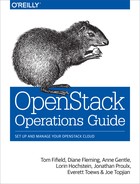Chapter 1. Provisioning and Deployment
A critical part of a cloud’s scalability is the amount of effort that it takes to run your cloud. To minimize the operational cost of running your cloud, set up and use an automated deployment and configuration infrastructure.
This infrastructure includes systems to automatically install the operating system’s initial configuration and later coordinate the configuration of all services automatically and centrally, which reduces both manual effort and chance for error.
Automated Deployment
An automated deployment system installs and configures operating systems on new servers, without intervention, after the absolute minimum amount of manual work, including physical racking, MAC to IP assignment, power configuration, and so on. Typically solutions rely on wrappers around PXE boot and TFTP servers for the basic operating system install, then hand off to an automated configuration management system.
Ubuntu and Red Hat Linux both include mechanisms for configuring the operating system, including preseed and kickstart, that you can use after a network boot. Typically these are used to bootstrap an automated configuration system. Alternatively, you can use an image-based approach for deploying the operating system, such as systemimager. You can use both approaches with a virtualized infrastructure, such as when you run VMs to separate your control services and physical infrastructure.
When you create a deployment plan, focus on a few vital areas because they are very hard to modify post-deployment.
Disk Partitioning and RAID
At the very base of any operating system are the hard drives on which the OS is installed.
You must complete the following configurations on the server’s hard drives:
-
Partitioning
-
Adding to a RAID array
The simplest option is to use one hard drive with two partitions:
-
File system
-
Swap space
RAID is not used in this setup.
This option is not recommended for production because if the hard drive fails, that entire server is down. Instead, we recommend that you use more than one disk. The number of disks determine what types of RAID arrays to build.
We recommend that you choose one of the following multiple disk options:
-
Option 1: Partition all drives in the same way in a horizontal fashion, as shown in the following diagram:

With this option, you can assign different partitions to different RAID arrays. You can allocate partition 1 of disk one and two to the
/bootpartition mirror. You can make partition 2 of all disks the root partition mirror. You can use partition 3 of all disks for acinder-volumesLVM partition running on a RAID 10 array.While you might end up with unused partitions, such as partition 1 in disk three and four of this example, it allows for maximum utilization off disk space. I/O performance might be an issue due to all disks being used for all tasks.
-
Option 2: Add all raw disks to one large RAID array, either hardware or software based. You can partition this large array with the boot, root, swap, and LVM areas. This option is simple to implement and uses all partitions. However, disk I/O might suffer.
-
Option 3: Dedicate entire disks to certain partitions. For example, you could allocate disk one and two entirely to the boot, root, and swap partitions under a RAID 1 mirror. Then, allocate disk 3 and 4 entirely to the LVM partition, also under a RAID 1 mirror. Disk I/O should be better because I/O is focused on dedicated tasks. However, the LVM partition is much smaller.
As with most architecture choices, the right answer depends on your environment.
Network Configuration
Network configuration is a very large topic that spans multiple areas of this book. For now, make sure that your servers can PXE boot and successfully communicate with the deployment server.
For example, you usually cannot configure NICs for VLANs when PXE booting. Additionally, you usually cannot PXE boot with bonded NICs. If you run into this scenario, consider using a simple 1 GB switch in a private network on which only your cloud communicates.
Automated Configuration
The purpose of automatic configuration management is to establish and maintain the consistency of a system with no human intervention. You want to maintain consistency in your deployments so you can have the same cloud every time, repeatably. Proper use of automatic configuration management tools ensures that components of the cloud systems are in particular states, in addition to simplifying deployment, and configuration change propagation.
These tools also make it possible to test and roll back changes, as they are fully repeatable. Conveniently, a large body of work has been done by the OpenStack community in this space. Puppet – a configuration management tool – even provides official modules for OpenStack.
An integral part of a configuration management system is the items that it controls. You should carefully consider all of the items that you want, or do not want, to be automatically managed.
Remote Management
In our experience, most operators don’t sit right next to the servers running the cloud, and many don’t necessarily enjoy visiting the data center. OpenStack should be entirely remotely configurable, but sometimes not everything goes according to plan.
In this instance, having an out-of-band access into nodes running OpenStack components, is a boon. The IPMI protocol is the de-facto standard here, and acquiring hardware that supports it is highly recommended to achieve that lights-out data center aim.
In addition, consider remote power control as well. While IPMI usually controls the server’s power state, having remote access to the PDU that the server is plugged into can really be useful for situations when everything seems wedged.
